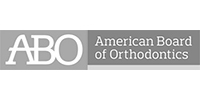
"Drs. Eggemeyer and Graham have been wonderful to work with. They have always been up front about our orthodontic treatment. I have friends at other orthodontic offices that seem surprised that their child needs a "Phase II" treatment. I knew from the initial consultations that two of my four girls were going to need multiple phases of treatment. We've been pleased with the results, the girls' smiles are wonderful! Thank you, Drs. Eggemeyer and Graham."- Margie
Straight teeth help an individual to effectively bite, chew and speak as well as contributing to healthy teeth and gums to alleviate future physical health problems. Teeth that work better also tend to look better with an attractive smile being a pleasant side effect of orthodontic treatment.
The American Association of Orthodontists recommends that all children get a check-up with an orthodontist no later than age eight. Although only a few orthodontic problems need to be corrected at that age, an early exam allows the orthodontist to offer advice and guidance as to when treatment should begin.
Orthodontic treatments benefit patients of any age. With many new orthodontic treatment options on the market, you can receive treatment without any of the wires or brackets. It is easier now than ever to maintain your professional look while on the road to healthier teeth and gums.
Orthodontists are dental specialists who dedicate their professional lives to correcting misaligned teeth and jaws. The members of the American Association of Orthodontists (AAO) limit their practices to serving clients in both orthodontics and dentofacial orthopedics. With extensive training in tooth movement and facial development after completing dental school, orthodontists are uniquely qualified experts in these fields.
A board certified orthodontist is a dentist who has completed an American Dental Association accredited graduate program in the specialty of orthodontics. They have then gone on to pursue the rigorous certification process which includes both written and clinical examination.
Certification is now awarded for a time-limited period and the orthodontists must re-examine on a periodic basis to retain the board certified status. Involvement in the certification process is a demonstration of the orthodontist’s pursuit of continued proficiency and excellence.
Braces are the tools orthodontists use to align and reposition teeth. There are a variety of options to choose from, including clear braces, ceramic braces, lingual braces, self-ligating braces, invisible braces, and traditional metal braces. Braces consist of the brackets which are fixed directly to each tooth and the archwires which connect to the brackets to do the tooth moving.
Yes, there are many different types of braces which allow for you to pick the treatment option most suitable for your lifestyle. The main differences include method of attachment to the teeth and their appearance. Brackets can attach to either the back or front of the teeth depending on the type of braces used and they vary in that some are nearly invisible, while others are made of stainless steel. All braces are designed to enable the orthodontists to move teeth in three dimensions to create an aligned, beautiful smile. Talk with your orthodontist about his or her approach to orthodontic treatment and find the solution that is right for you.
The length of treatment depends on the type and severity of the orthodontic condition treated and differs for each patient. On average, treatment takes about 22 months, but it can last between six and 30 months.
Braces are lumpy and bumpy. Your cheeks and lips get used to this in a few days. Moving your teeth will make them sore for the first few days. We recommend taking the over-the-counter medication your doctor recommends for a headache and also a soft diet.
No. Shots are not necessary for orthodontic treatment.
Remember to brush and floss everyday, as it is easier for food to get trapped in the crevices in the brackets. You should also avoid eating hard or chewy foods that can damage your braces. For detailed information on caring for your braces and eating with braces, please see our pages Brushing & Flossing and Foods to Avoid in the Braces Care section.
You should brush your teeth after every meal while wearing braces to remove any lingering food and keep your mouth clean and healthy. You may use either an electric or manual toothbrush.
Yes. Playing a sport or playing an instrument with braces can take some adjustment, but braces will not prevent you from doing the activities you enjoy. Just remember to wear an orthopedic mouthguard during contact sports to avoid injury or damage to your braces. Wax may be helpful for the adjustment periods.
Yes. Seeing your dentist for checkups are even more important while receiving orthodontic treatment. While wearing braces, it is easier for food to get caught in spaces you toothbrush can’t reach, which can cause cavities and gum disease. Regular visits to your dentist help keep your teeth healthy and clean during your treatment.
The price of braces depends on many different factors, including the type of braces used and each individual patient’s orthodontic condition, so it is difficult to give a general estimate for everyone. Ceramic and lingual braces can cost slightly more. Talk to our office to discuss the most cost effective solution for your treatment.
Check with your provider if you have dental insurance. Often, orthodontics may be covered by dental insurance. Usually, dental insurance does not cover the cost of orthodontics for adults, but may partially cover treatment for children under the age of 18. Typically, there is a lifetime maximum benefit for each family member.
No. We feel every patient should be provided new appliances for the best, most predictable result.
Please call our office at (847) 256-3236 Monday-Thursday, 8am-5pm, or fill out the ‘request an appointment’ form on the Contact Us page.






